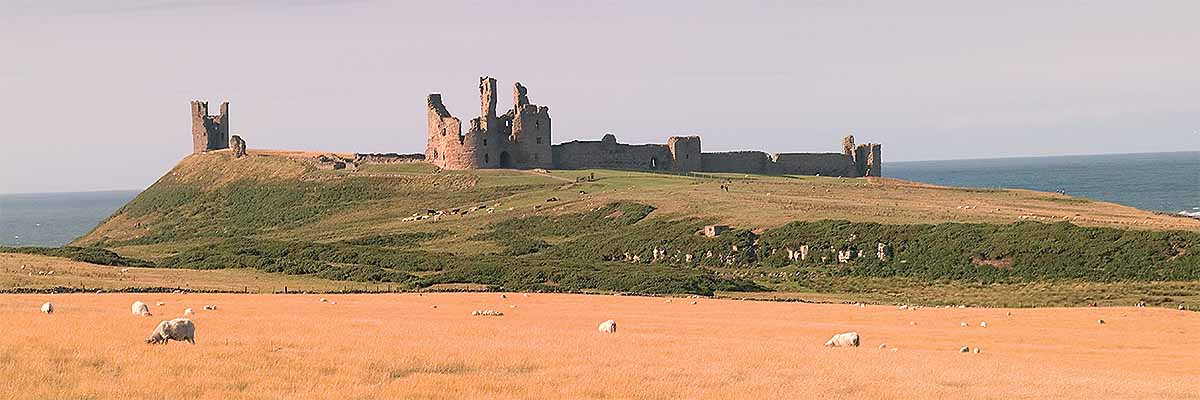Significance of Dunstanburgh Castle
Dunstanburgh Castle presents a rare combination of the informative and atmospheric. The castle now comes to us in a state more heavily ruined than many others in English Heritage’s guardianship, but is both overpowering in scale and incomparable in its setting. The structures that do survive are of great architectural quality.

DUNSTANBURGH IN MEDIEVAL HISTORY
Although the castle’s builder, Thomas, Earl of Lancaster, saw the castle once at most, the surviving structures at Dunstanburgh suggest his personal ambition more strongly than the remains of his other castles (such as Pontefract).
In the later Middle Ages and beyond, Dunstanburgh was perceived as a key element in an important group of castles, together with the royal Bamburgh, and the baronial Alnwick and Warkworth, both associated with the Percy family.
During the Wars of the Roses (1455–85) – when Dunstanburgh saw the only known military actions in its history – the control of these castles of the east march became important for both Yorkists and Lancastrians. The keepers of Dunstanburgh Castle tended to favour the latter, which has led to later associations with Queen Margaret of Anjou, most of them historically improbable.
THE CASTLE IN THE SECOND WORLD WAR
The defences constructed around the site during the Second World War – with a pill-box, anti-tank trenches, gun emplacements and a minefield – testify to the hurried fortification of this part of the Northumberland coast in 1940 to counter a threat of German amphibious assault on Embleton beach, immediately north of the castle.
ARCHITECTURAL IMPORTANCE
Dunstanburgh Castle is the largest castle in Northumberland. Though it lacks the sophisticated domestic buildings of such nearby sites as Warkworth and Alnwick, and the internal layout of the castle is imperfectly known, it is architecturally significant in several respects.
The surviving buildings of the south curtain wall with its mural towers and the Lilburn Tower on the western flank show the plain forms of architectural features such as doors and windows. Such features, and the rectangular form of most of the towers, demonstrate a strong regional character.
Enough survives of Thomas of Lancaster’s great gatehouse to show that its designer, probably the ‘master Elias the mason’ mentioned in the 1313–14 account, was a builder of great ability and national importance.
The fact that the gatehouse was built in the generation following the reign of Edward I, and that its rounded turrets are unlike the other structures in the castle (and in the wider region), has led to the building being interpreted as a variant on the celebrated gatehouses of Edward I’s castles, particularly those built in the castles of north Wales, such as Harlech and Beaumaris.
While in general terms this association is useful and informative, the building at Dunstanburgh has significant differences in plan, elevation and some architectural detailing. The vertical projection of the frontal turrets in particular is a daring work of engineering and construction. No immediate precursors have yet been identified, though it has been suggested that it has analogues with the convention of castle architecture as rendered in slightly later stained-glass windows.[1] Equally, Dunstanburgh did not spawn any close imitations.
LANDSCAPE AND SETTING
The landscape immediately around the castle has great potential to elucidate the history of the site (see below), but to thousands of visitors every year who use the Northumberland coastal path, Dunstanburgh Castle has greater aesthetic significance.
Especially in the view from the south, with the castle and the great gatehouse standing on a high but gentle slope above the sea, the ruins present a jagged outline of great power and presence. The castle’s setting when viewed from the north is no less impressive.
For many visitors, the cliffs also provide a vantage point for watching the different species of seabirds that colonise the site, or for sea fishing on the tip of the headland beside the Rumble Churn. The bailey is a Site of Special Scientific Interest (SSSI) as a nesting ground for sea birds, contiguous with other SSSIs on the foreshore.
THE ROLE OF ARCHAEOLOGY
Fieldwork and documentary research undertaken between 2003 and 2006[2] have revealed that the medieval castle accounts for only one phase in a history of occupation spanning millennia, and that the form of the castle needs to be reassessed (see Research).
Such work not only has numerous implications for the understanding of the castle and particularly the motivations of Thomas of Lancaster in ordering its construction, but has great potential to inform the study and understanding of other medieval castles in England and beyond.
READ MORE ABOUT DUNSTANBURGH CASTLE
FOOTNOTES
1. Anna Eavis, personal communication.
2. A Oswald, J Ashbee, K Porteous and J Huntley, Dunstanburgh Castle, Northumberland: Archaeological Research and Historical Investigations, English Heritage Research Department Report 26/2006 (Swindon, 2006).
